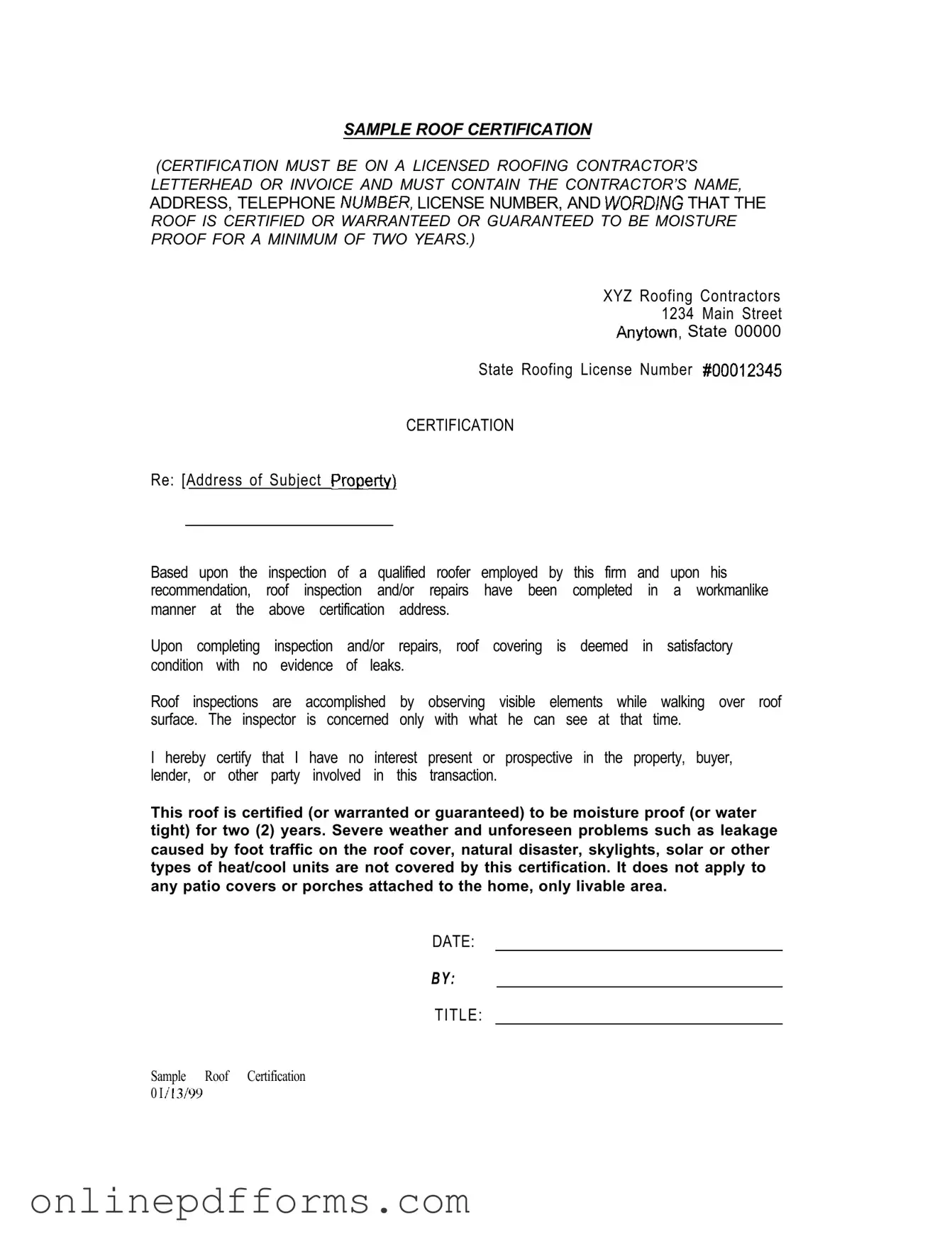The Sample Roof Certification form bears similarities to a Home Inspection Report. Both documents serve as evaluations of a property’s condition, focusing on structural integrity and potential issues. A Home Inspection Report typically provides a comprehensive overview of various systems within a home, including roofing, plumbing, and electrical systems. Like the roof certification, it is prepared by a qualified professional who inspects the property. However, the Home Inspection Report covers a broader scope, while the roof certification is specifically focused on the roofing system's moisture-proof capabilities.
Another document akin to the Sample Roof Certification is the Warranty Deed. A Warranty Deed is a legal document that guarantees a property title is clear of any liens or claims. Both documents provide assurances; the roof certification assures the buyer of the roof's condition for a specified period, while the warranty deed assures the buyer of ownership rights. The key difference lies in their focus: one pertains to physical condition, while the other pertains to legal ownership.
The Roof Inspection Report is another closely related document. This report is generated after a thorough examination of the roof, similar to the certification. It details the condition of the roof, identifies any issues, and may recommend repairs. While the roof certification states that the roof is moisture-proof for two years, the inspection report may not include such guarantees but instead provides a detailed account of the roof’s current state.
A Certificate of Insurance is also similar in that it provides assurances regarding coverage. This document verifies that a contractor has liability insurance, which protects against potential damages during roofing work. While the roof certification focuses on the roof's condition post-inspection, the certificate of insurance assures clients that the contractor is financially responsible for any mishaps that may occur during the job.
The Maintenance Agreement is another document that shares similarities with the Sample Roof Certification. This agreement outlines the terms under which a contractor will perform routine maintenance on a property’s roof. Like the roof certification, it emphasizes the importance of maintaining the roof’s integrity. However, the maintenance agreement often includes ongoing obligations, whereas the certification is a one-time assurance based on a specific inspection.
The Property Condition Disclosure Statement is also relevant. This document requires sellers to disclose known issues with the property, including the roof's condition. While the roof certification assures buyers of the roof's current state, the disclosure statement serves as a legal obligation for sellers to inform buyers of any problems. Both documents aim to protect the buyer but from different angles.
The Homeowner’s Insurance Policy can also be compared to the Sample Roof Certification. This policy provides coverage for damages that may occur to the home, including the roof. While the certification guarantees the roof's condition for a specified time, the insurance policy protects against unforeseen damages that may arise after that period. Thus, both documents play crucial roles in safeguarding the homeowner's investment.
The Georgia RV Bill of Sale form is a vital document that acts as proof of purchase and transfer of ownership for recreational vehicles in the state of Georgia. It ensures that all parties involved have a clear record of the sale details, including the buyer, seller, and specifics about the RV. Utilizing this form is essential for the legal and smooth transition of ownership, similar to the way Auto Bill of Sale Forms facilitate the process of transferring vehicle ownership.
The Contractor’s Invoice, particularly when it includes warranty language, is another document that may resemble the roof certification. An invoice details the services rendered and often includes terms related to warranties or guarantees. While the roof certification is specifically focused on the roof's moisture-proof status, the invoice may provide a broader overview of services while still assuring the homeowner of quality workmanship.
Finally, the Building Permit serves as a document that ensures compliance with local building codes and regulations. While it does not specifically address the roof's condition, it is often required before roofing work can commence. Both the building permit and the roof certification are essential for ensuring that the work performed meets safety and quality standards, albeit from different perspectives.
